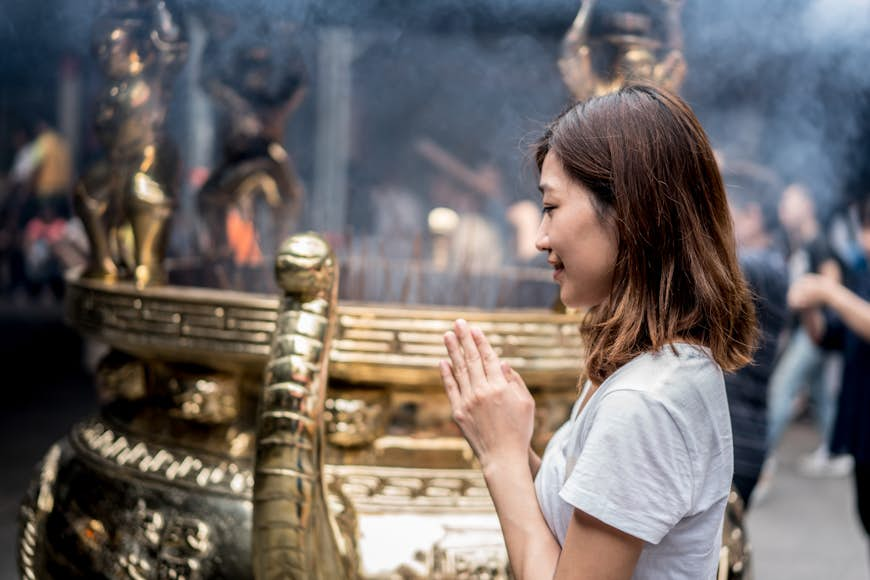Taiwan is a country with more facets than the 11-headed Guanyin you’ll see inside its temples. On any one trip you could be cycling between skyscrapers, drinking coffee at plantations, sun-bathing, forest-bathing, soaring on luscious homegrown whisky, or reeling from rocket fireworks or the repertoire of a night market. The options are endless.
So whether you’re a first-time visitor or coming back for more, and making up your mind on what to do might just be the hardest part of your trip. Here are some of the best experiences in Taiwan.
1. Take your pick of 15,000 temples
Pick a couple, if not more. Whether incense-filled and packed to the eaves with idols and art or a dusky roadside shrine, whether Taoist, Buddhist, Confucian or folk, temples offer a fascinating glimpse into Taiwan’s spiritual life. You’ll see devotees, including a surprising number of young people, praying and giving thanks. They burn joss paper for the departed, toss moon blocks to seek divine guidance on whether to buy a car, and make offerings of guava, orchids and sesame crackers to a pantheon of deities. During festivals, temples offer up a smoky and noisy slice of local life. On quiet days, with their relics, sculptures and caisson ceilings, temples are museums in their own right.
Both Tainan and Lukang are home to a wealth of old structures, from understated Confucius temples to Mazu temples rich in southern Chinese folk decorative art. Some favorites from all over the country are Taipei’s Unesco-award winning Bao’anTemple, Lukang’s graceful Longshan Temple, Penghu’s old Tianhou Temple, Tainan’s fierce City God Temple, and Changhua’s Nanyao Temple with its Doric columns.
Local Tip: Entering a temple the proper way – through the “dragon door” on the right-hand side, and exiting through the “tiger door” on the left means you go into protection and leave danger behind. Surely you wouldn’t want it the other way round. The center door is reserved for the gods, the abbot, and the president.
2. Sunbathe on Jibei Sand Tail, Penghu Islands
The windy collection of islands known as Penghu is distinctive yet hard to pin down. Set along its roaring coastlines are sea-facing temples, coral stone-walled villages where vendors sell seashell pendants and prickly pear sorbet, and beaches good for water sports – in winter Penghu becomes a windsurfing hot spot for top-class athletes the world over.
Added to this mix are geological wonders, a large aquarium, and remnants of ancient sea trade in all their desolate splendor. Further still, Penghu cuisine is celebrated for its delicious simplicity and plentiful seafood. Best of all, though, if you come out of season the golden spit known as the Jibei Sand Tail could be all yours.
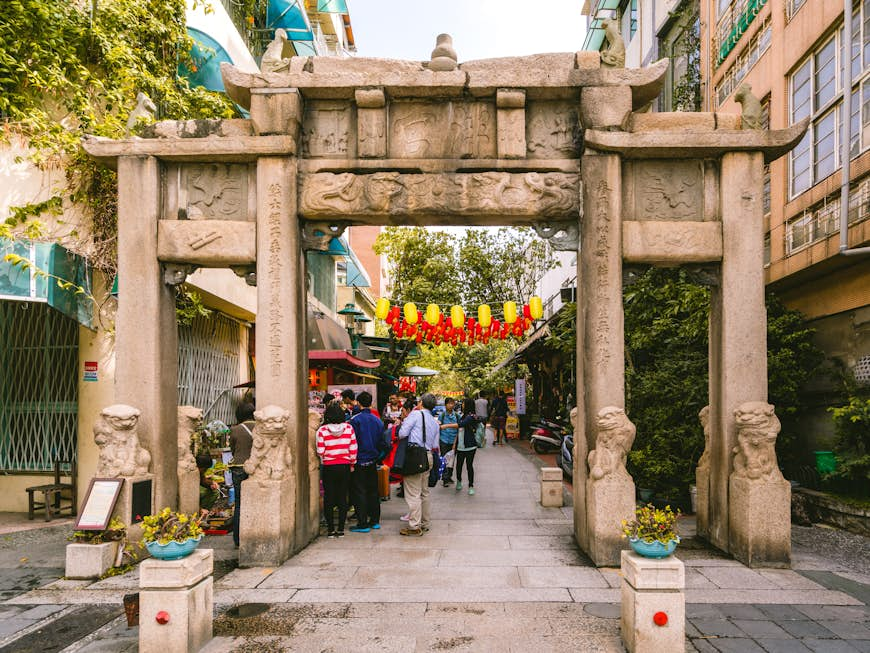
3. Explore urban Tainan on foot
Urban Tainan has such a tight weave of attractions that walking is the best way to take everything in. What’s more, cafes, restaurants and dessert shops are liberally tucked into the fabric, offering abundant options for a refuel. And should you need some tiding over, there’s the T-bike and bus.
Many sights are clustered around the roads radiating from the Tang Te-chang Memorial Park roundabout in central Tainan. You’ll see close to the rim the Museum of Taiwan Literature in a gorgeous Japanese colonial building, and the Altar of Heaven. Slightly further out are the Neoclassical Land Bank, the art deco Hayashi Department Store, the old and the new Tainan Art Museums, the Confucius Temple with its red walls, and the City God Temple. Further out still are the Great South Gate, Koxinga’s Shrine, Chihkan Towers, the Official God of War Temple, and the Grand Mazu Temple.
From the roundabout, a 15-minute stroll northwest takes you to Shennong Street, an art village with shophouses repurposed into boutiques and cafes. Sharing the ‘hood with the hipsters are the Wind God Temple, the Water Fairy Temple and the King of Medicine Temple.
Planning Tip: Famous Anping Fort and the old streets sagging with traditional snack shops near it are 15 minutes away by T-bike or 45 minutes by bus from Shennong Street.
4. Hike along Swallow Grotto at Taroko Gorge
Taiwan’s top tourist draw is a walk-in Chinese painting. Rising above the froth of the blue-green Liwu River, the marble walls (yes, marble!) of Taroko Gorge swirl with the colors of an artist’s palette. Add grey mist, lush vegetation and waterfalls seemingly tumbling down from heaven, and you have a truly classic landscape. Walk along the Swallow Grotto to see the gorge at its most sublime or brave the Zhuilu Old Trail, a vertiginous path 500m (1640ft) above the canyon floor.
5. Cycle or drive along the breathless East Coast at Hualien
Cycling is Taiwan’s national sport, and cyclists favor the stunning and unspoilt east coast for multi-day trips. Love the sea? Then ride the gorgeous coastline along the Pacific Ocean, between Yilan and Hualien or Hualien and Taitung. It’ll leave you breathless in more ways than one.
There are dramatic elevation changes in Taroko Gorge, and portions of the highways are subject to landslides after heavy rain. But the beauty is unparalleled and you’ll pass beaches, fishing harbors, indigenous towns and art villages. Like the mountains? Ride the East Rift Valley and watch cloud drama unfold on glistening rice paddies or seas of orange daylilies. On both routes there are indigenous guesthouses and restaurants, campgrounds, prehistoric sites and hot springs to ensure your trip won’t be an exercise in logistics.
Local Tip: If you charter a car from Taipei, the driver will make stops at scenic spots and attractions.
6. Do a homegrown coffee crawl and buy beans
Blessed with good soil, and a climate and altitudes conducive to arabica trees flourishing, Taiwan has become the coffee mecca of Asia, bagging awards worldwide for its beans that range from peanutty to tea-like. You can sip them at their source in Gukeng and Dongshan if you’re hiking nearby, but it’s more fun to try different cafes that serve killer homegrown brews and also roast and sell beans. A bonus is the setting, which can range from retro Taipei through hipster book-and-bean to Nordic minimalism.
Detour: Cacao farms in Pingtung grow beans and craft some of Asia’s finest chocolates. You can tour the premises, learn about the bean-to-bar process, and make your own sweets at Choose Chius and Fu Wan Chocolate.
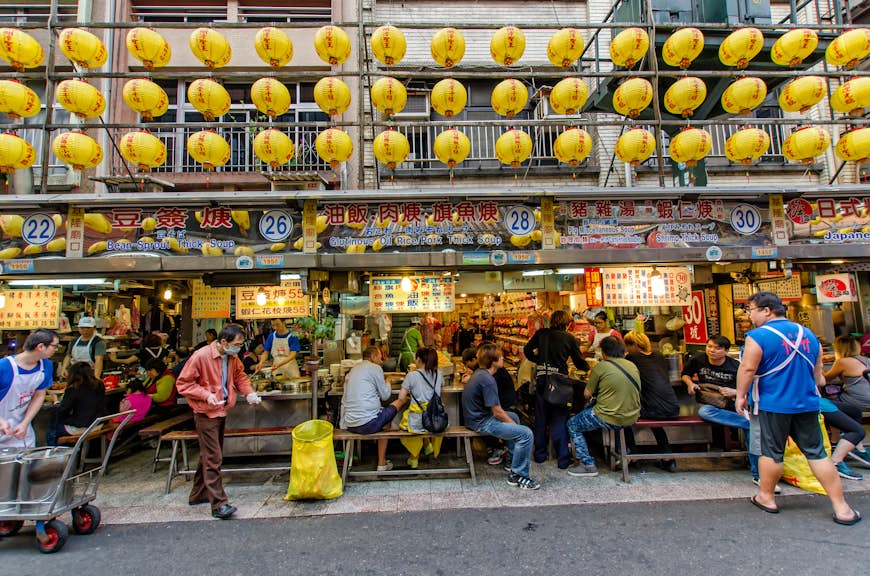
7. Enjoy a feast at Miaokou Night Market, Keelung
Grazing is a useful technique to have on the road and Taiwan’s night markets are great for honing this skill. Fulfilling the need for food and entertainment (to say nothing of socializing), the markets bring happy crowds every night of the week to gorge on a bewildering array of snacks and dishes. Check out harborside Miaokou Night Market in Keelung, in many ways the biggest and best of them all, for the quintessential experience of grazing (on seafood especially!) and people-watching.
8. Get a taste of gourmet Taiwan in Mountain and Sea House, Taipei
Taiwan may be one of the world’s street-food capitals, but don’t just limit yourself to casual eats – the country’s dining landscape has plenty more to offer. Taiwan is steadily making a mark on Asia’s culinary landscape. In the 2022 Michelin Taiwan, Kaohsiung, Taichung, Taipei and Tainan came under scrutiny and earned the country 38 stars, up from 20 and only Taipei assessed in 2018.
The lists don’t just honor chefy French-style cooking, expensive Japanese or meticulous Cantonese kitchens, but also solidly executed Taiwanese cuisine, such as Taipei’s Mountain and Sea House. Besides this, a growing number of chefs with or without awards are working magic with local produce from oolong tea to sakura shrimp, like Pingtung’s AKAME which specializes in Rukai cooking.
Planning Tip: Reserve at least a month in advance for famous restaurants, Michelin-honored and otherwise.
9. Be wowed by the National Palace Museum, Taipei
Taiwan houses one of the greatest collections of dynastic Chinese artefacts in the world. With ancient pottery, bronzes and jade, Ming vases, Song landscape paintings and calligraphy that even those who are not art lovers can appreciate, Taipei’s National Palace Museum isn’t merely a must-visit, it’s a must-repeat-visit. Why? Out of the nearly 700,000 pieces in the museum’s collection – spanning every Chinese dynasty, in addition to prehistory and the modern-age – only a fraction is ever on display at the one time.
10. Delve into military history while enjoying art at Alien Art Center, Kaohsiung
The military outposts of Kinmen and Matsu Islands with their tunnels, forts and artillery displays will please hardcore military buffs, but if you want something softer and unique enough that everyone can enjoy, head to Kaohsiung. The dark and mysterious national relic that is the Imperial Japanese Navy Wireless Communication Station has finally found peace but for tent shows and exhibitions. Alien Art Center, housed in a former hostel for young men departing for military service, is one of Taiwan’s strongest contemporary art museums. Cihou Fort on Cijin Island was used by the Qing Empire, the Japanese, the Nationalist Army, and more recently, tripod-wielding sunset photographers.
The engaging Military Dependents’ Village Museum shows how the families of soldiers of the Chinese Nationalist Army lived after their retreat to Taiwan post-1949. The high-rises of Guomao Community are the 2.0 version of such villages. Do as the locals do – go there to enjoy authentic regional Chinese cuisines at the restaurants. In a compound next to Taiwan’s largest naval base, the Story House of Naval Base Zuoying details the area’s military heritage.
Detour: New Taipei’s Human Rights Museum, sitting on the site of a former detention center for political dissidents, is recommended for insight into how far democratic Taiwan has come. The English audio guide is helpful. The museum’s sprawling branch on Green Island, a former penal colony, can be visited by booking a guided tour.
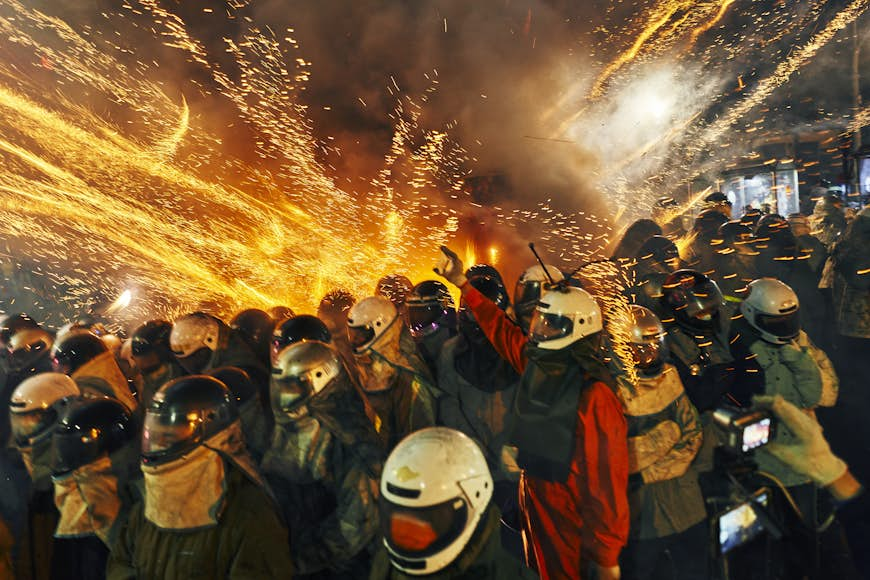
11. Join locals in hazmat suits at the Yanshui Beehive Fireworks Festival
Attending a traditional folk festival is one of the most exhilarating ways to experience local culture. Taiwan has a slew of these – solemn, bizarre, carnivalesque, you name it. You don’t have to be a believer to go – the locals are inclusive and welcoming, but be respectful of course. It is not uncommon to see pilgrims and visitors from all over Taiwan and abroad at the most spectacular festivals.
The nine-day annual Mazu pilgrimage sees hundreds of thousands of people escorting a palanquin containing a statue of the goddess Mazu through 50 towns. The triennial Burning of the Wang Yeh Boats features powerful spectacles over eight days that end with the burning of a celestial boat on a beach. The strange Yanshui Beehive Fireworks Festival is a blowout in which thousands in protective gear (or not) place themselves willingly in a melee of exploding fireworks.
Planning Tip: The Mazu Pilgrimage takes place in the third lunar month; the Boat Burning Festival in October or November, with the next one happening in 2024; and Yenshui’s fireworks go off on the 14th or 15th day of the first lunar month. If you attend the last, bring goggles, a motorcycle helmet and protective clothing if you don’t want to pay for overpriced gear on-site or end up in hospital.
12. Follow ancient hunting trails through forests in Wulai
Taiwan is 50% forested and asphalt gives way to the real thing astonishingly quickly – a delight for nature-lovers. In mountainous Wulai township, old indigenous hunting trails cut through misty tropical forests.
Take a break from your trek to enjoy crystal streams or deep swimming pools and repeat this experience all over the island. Taiwan is also two-thirds mountainous, with hundreds of peaks soaring above 3000m (9842ft) and well-established hiking routes running all over. Jade Mountain (Yushan) is the highest peak in Northeast Asia, but the second highest, Snow Mountain, is a more picturesque climb.
13. Understand Indigenous Taiwan at Shung Ye Museum of Formosan Aborigines
There are 16 recognized indigenous tribes in Taiwan. Though long suppressed, tribal culture and pride has made a remarkable turnaround in the 21st century. Begin your understanding at the Shung Ye Museum of Formosan Aborigines in Taipei or the Museum of Prehistory in Taitung. See their paintings and installations at the Kaohsiung Museum of Fine Arts, a world-renowned authority on Austronesian art, hear them read their poems at Tainan’s Museum of Taiwan Literature.
Then check into an underground homestay run by Yami islanders on beautiful Lanyu Island, preferably during the flying fish season, or consider a visit to the communally run Smangus, a high-mountain center of Atayal culture. In summer, head to the east coast for indigenous surfer towns and exuberant festivals celebrating harvests, coming of age, and a deep love of live music.
Local Tip: Sample Amis delicacies in Hualien. You can do so at the indigenous stalls in Dadongmen Night Market or at Amis-run Mu-Mang.
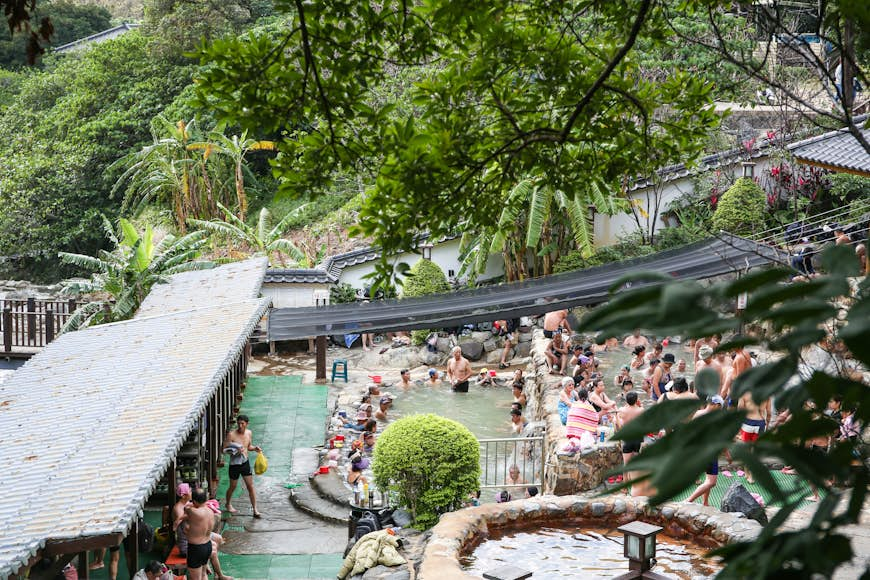
14. Relax in Beitou’s hot springs
Taiwan’s ground surface has plenty of fissures, which gives rise to an abundance of spring sources hard to match anywhere on the globe. Locals believe the waters are effective for everything from soothing muscles to conceiving.
If you like to soak in stone, wood or marble pools with mountain views, head to Beitou, Wulai or Taian. For wild impromptu dips, tread deep into valleys for a pristine wild spring like Lisong Hot Spring, often considered the most beautiful of them all, or make your way to Green Island for one of the world’s three seawater hot springs.
15. Tour the Kavalan Distillery to see how Taiwan’s single malts are made
Whisky lovers, you’re in luck. Taiwan is a country of whisky drinkers, and they’re not only sipping imported Laphroaig or Hibiki – Taiwan’s own award-winning Kavalan is a huge favorite. The world seems to agree – at the Asia round of World Whisky Masters 2022, the homegrown label scooped 10 golds plus a Master Medal. You can try Kavalan on the rocks or in a smoky martini at one of the country’s many exquisite cocktail bars such as Taichung’s Goût and Taipei’s Ounce, but you can also tour the distillery in Yilan for free and sample (of course!) the single malts.
Local Tip: Taiwan has a lively craft beer scene with microbreweries popping up all over, but it’s best to taste homegrown beer in a bar such as Zhangmen, Le Blé d’Or and Taihu.
